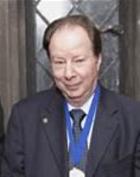Sidney Altman
Sterling Professor of Molecular, Cellular, and Developmental Biology and Professor of Chemistry
 Sidney Altman, B.S. MIT, Ph.D. University of Colorado, faculty member at Yale since 1971: You were raised in Canada and in a sense destined for McGill, so we feel lucky that, as a boy, without quite knowing what you were doing, you sat for the SAT and ended up in this country, on a circuitous path to a great scientific career. Although you trained as an undergraduate in physics, a course in introductory biology stimulated your interest, and after a short graduate stay in physics at Columbia you moved to Colorado, joined the Leonard Lerman lab, which was working on DNA, and found your intellectual home. You then moved to Harvard to join Matthew Meselson’s lab and after that to England, where you joined a research group at Cambridge that started you along the research path that led to your seminal discovery that RNA has catalytic properties and actively aids chemical reactions in cells. Like much seminal work, your revolutionary discovery upended firmly established scientific principles that molecules could either carry information, like RNA, or catalyze chemical reactions, like proteins, but could not do both. You proved they could do both and that the RNA component in isolation, without the protein subunit, was sufficient for the observed catalytic activity of the enzyme.
Sidney Altman, B.S. MIT, Ph.D. University of Colorado, faculty member at Yale since 1971: You were raised in Canada and in a sense destined for McGill, so we feel lucky that, as a boy, without quite knowing what you were doing, you sat for the SAT and ended up in this country, on a circuitous path to a great scientific career. Although you trained as an undergraduate in physics, a course in introductory biology stimulated your interest, and after a short graduate stay in physics at Columbia you moved to Colorado, joined the Leonard Lerman lab, which was working on DNA, and found your intellectual home. You then moved to Harvard to join Matthew Meselson’s lab and after that to England, where you joined a research group at Cambridge that started you along the research path that led to your seminal discovery that RNA has catalytic properties and actively aids chemical reactions in cells. Like much seminal work, your revolutionary discovery upended firmly established scientific principles that molecules could either carry information, like RNA, or catalyze chemical reactions, like proteins, but could not do both. You proved they could do both and that the RNA component in isolation, without the protein subunit, was sufficient for the observed catalytic activity of the enzyme.
Your discovery was so radical that at first you had difficulty publishing your findings. Ultimately, however, that achievement earned you wide recognition and a share, along with Thomas Cech, of the Nobel Prize in Chemistry in 1989. After winning the highest award that any scientist can receive, you frequently gave a talk that explained to the public at large the conflicting challenges of doing American science: it is hard for young scientists to win grants for revolutionary ideas because people are skeptical of them. But that is the nature of revolutionary ideas, and they are the ones that often help uncover the mysteries of the universe.
Some might think that the Nobel Prize is quite enough of an achievement for one lifetime, but at Yale you have coupled it with others. In fact, one might say you have achieved the Yale faculty trifecta: you did distinguished work of the highest order; you chaired your department; and then, for four years in the late ’80s, you were the dean of Yale College. In that role, one of your primary initiatives was to enhance the science requirement, as well as the language requirement, and in this and more you worked closely with the associate deans of Yale College, with whom you found comradeship and a good working relationship. Along the way you also achieved deep-rooted friendships with some unique figures who were lost too early: Dean Martin Griffin, Jr., whose wit, devotion to Yale College, company, and conversation you valued; and President Bart Giamatti, with whom you had great affinity and rapport, and with whose administration you are inextricably linked. It is no surprise that you and President Giamatti were close allies: while a distinguished scientist yourself, you have all the attributes of a humanist. You read widely, write beautifully, and have always had a serious interest in literature, which shows that there is no C.P. Snow divide in your personal world. As you retire, Yale salutes you for representing the highest ideals of its intellectual mission, and—Boola Boola—for your contributions to the wider Eli community.
Tribute Editor: Penelope Laurans